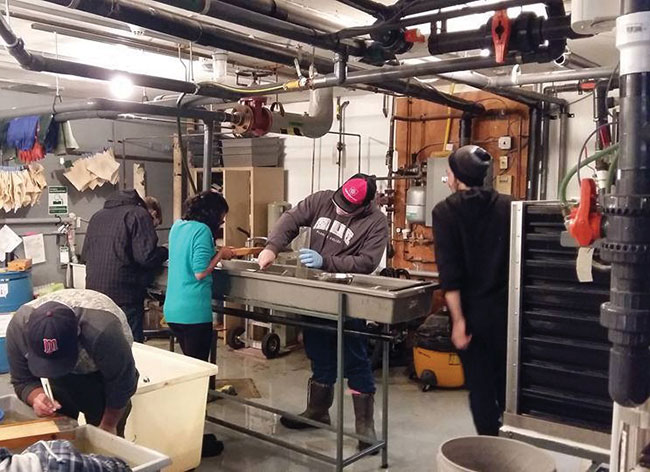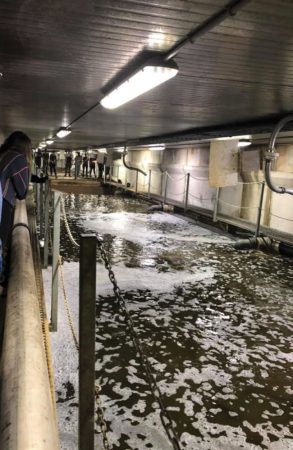
Features
Enter the AquaDen – Aquaculture Enterprises
Fleming College makes students face reality with RAS facility pitch project
October 19, 2021 By Ron Hill
 Students work in the RAS hatchery each day to build their skills and knowledge.
Photo: RON HILL
Students work in the RAS hatchery each day to build their skills and knowledge.
Photo: RON HILL It’s a daunting task to start a business, create a convincing business plan and pitch it to investors, let alone for an aquaculture venture. Finding funding is an unfortunate reality of starting a business. The Canadian television show Dragon’s Den, (or Shark Tank in the United States), while made for television and filled with sensationalism, gives good insight into how pitches to investors are made, won, and lost. It is upon this model, with a bit less sensationalism, that students studying Fleming College’s post-graduate certificate in sustainable aquaculture in Lindsay, Ont., Canada, tackle their major project in the course; they must enter the AquaDen and face the Dragon Fish.
The Dragon Fish
Chief among the Dragon Fish is aquaculture program coordinator and AquaDen creator, Prof. Jon Carter. “When I took over the aquaculture program in 2014, there was an aquaculture business course that was largely undeveloped, it was a series of unrelated lectures. I redeveloped the entire concept and renamed the class Aquaculture Enterprises. I wanted something engaging and challenging that would get the students to learn about the business and building side of aquaculture but also let their creativity, ingenuity and everything they learned in the program, culminate in one engaging project,” says Carter of the project’s genesis. “It was important to me the project have a recirculating aquaculture system (RAS) focus because of the added complexity. RAS has also become a larger part of the industry and it’s what the students are used to dealing with [at the college].”
The rules
A daunting task becomes a daunting project. Students are divided into groups of three or four and given the project to come up with an aquaculture facility and business model to pitch the Dragon Fish in the AquaDen, asking for the funding they need to follow through with the idea. The only stipulation is the facility must be a RAS. Students must find and include the land, development, building (or retrofitting) and operations expenses. A species must be chosen, a production plan and facility layout must be provided as well as an equipment list, the fish and egg sourcing, and all the details needed to operate their business including staffing, sales, marketing, and transportation. Students must also evaluate risk and explain how they are mitigating potential risks and catastrophes.
Students are given some standard numbers and prices for building and equipment. As well, it is assumed that all required permits for land and water use, aquaculture licences and wild collection permits, will be granted.
“I was concerned the students would be reaching out to suppliers and contractors for pricing, so I decided to add some standard costs for things like building, running powerlines, and some basic aquaculture equipment. They can use the basic equipment costs to scale up to larger models, scaling their costs as well,” explains Carter. “The focus is not on the exact costing, but of the process of budgeting and figuring out what is needed. They need to find a real piece of land that is for sale and evaluate the cost, location, and water source for their project. I wanted this project to give students an appreciation of aquaculture from the investor, owner, and worker point-of-view.”
The goal of the students is to compile all their work into a digestible business plan and presentation. Once all components of the project have been created and compiled by the group, they must enter the AquaDen and present to the Dragon Fish. Students are expected to dress nice as the setting moves from classroom to conference room. The Dragon Fish (professors and guests), listen to the students pitch their business plan, building plan, and facility. Students summarize their presentation by requesting for the financing they need to fund the building and early operations of the farm. At this point, the Dragon Fish begin the questioning processes.
Facing the Dragon Fish
The culmination of the project, when the students must face the Dragon Fish with their completed pitch, is the most difficult part. Their AquaDen presentation represents the lion’s share of the grading for the class as well. All the effort and work from the whole semester comes down to the grade they receive during their presentation, adding to the anxiety.
Hunter Remen faced the Dragon Fish in 2016 with her team and their mega project: “Our idea was the world’s only vertically integrated walleye (Sander vitreus) commercial RAS production facility. Egg through grow out, plus developing and keeping our own broodstock.”
Remen found facing the Dragon Fish a harrowing and humbling experience.
“It was very nerve racking, so much time and effort goes into the project. Our presentation went very well, very smooth and we got everything out there for the panel, but we were still very nervous. We made sure we each knew all the details so we could answer questions. We thought we knew everything, then they started asking questions,” she explained with a sigh. “Then you see all the things you didn’t think about. Lack of redundancy was said a lot to our group.”
The judges scrutinize the ideas thoroughly, making sure the group can answer basic questions about their project but also flushing out the plan and pointing out weaknesses and potential stumbling blocks.
The unprepared should enter the AquaDen wearily as the Dragon Fish’s pointed questions quickly determine how much effort went into the project and can expose those who didn’t contribute.

All classes, projects and facility visits culminate in the AquaDen project, students must use everything they have learned in the course.
Photo:Ron Hill
Passing and winning
Students are both evaluated and judged during the presentation. Students are evaluated with a standard rubric for their project – public speaking, their presentation quality, and the thorough development of their ideas – and receive marks for their project. Students are judged based on the merits of their idea to succeed in the real world and are awarded the requested funding based on merit. Groups can do very well on the project and receive top marks, but still receive no funding because the judges feel the idea isn’t a realistic business or carries too much risk. Any group can receive funding from the Dragon Fish, and many years have multiple winners. There can also be disagreement among the Dragon Fish, with different Dragon Fish funding different projects.
An educational experience
“Someday the students will have to present ideas in the real world, and I want them to be able to take this huge project down to a concise 20-minute pitch of what we need to know. It’s definitely stressful but the students enjoy the project,” Carter explains. “When I started this project, I thought there would be a lot of trout farms because they are familiar to the students, but many students think outside the box, choosing a huge variety of species. We have had more species of fish than I can think of, ornamentals, crabs, sea cucumbers, as well as farms that focus on certain phases or life cycles such as fingerling farms. Small farms to megaprojects and everything in between.”
Felicia Meloche, who works at Manitoulin Trout Farms hatchery in Coldwater Ont., took the aquaculture course in 2019 and remembers the project well. “Our group wanted to choose something out-of-the-box, so we chose the Chesapeake Bay blue crab (Callinectes sapidus),” she recalls. “We quickly found out that going out-of-the-box would be tricky. We soon realized that blue crabs are endangered. We decided to locate the facility in Maryland so we could obtain a wild collection permit and start a broodstock. We then learned that the blue crabs only spawn once and therefore, we would have to keep a portion of our stock each year for the next year’s seed. Because the crabs can’t be housed together, we needed to build divided tanks, and then come up with all the costs to build a custom housing facility; it all took a long time. There we so many challenges we hadn’t thought about.”
Despite the challenges, Meloche felt the project was a huge benefit to her aquaculture career. “You really get another layer of skills out of the project and a new level of understanding. It brings up problems that I wouldn’t have considered just working at a facility. We fought with the spacing of the tanks, trying to get it just right, trying to work out the thousands of dollars worth of piping. It’s such a different perspective when you look at a RAS facility from a build point-of-view.”
Preparing for reality
The Aquaculture Enterprises class forces students to face the financial and engineering considerations that go into RAS systems like no other. Unlike most programs and education in aquaculture, the reality of the financial aspects of farm building and farm operation are driven home, as the students rarely ask the Dragon Fish for less than millions of dollars for their startups. For students, the skills learned in the project through building, budgeting, and planning are practical and transferrable to many applications, while still fueling their interesting and cultivating their knowledge with RAS. As Hunter Remen puts it: “You have to think of everything from how many chairs and pencils you need, to feed forecasting, to redundancy.” This class gives the students an appreciation and respect for the degree of difficultly involved in a RAS startup, the vast amounts of work involved, and above all the huge costs, that many potential RAS builders and farmers would be wise to observe.
Print this page